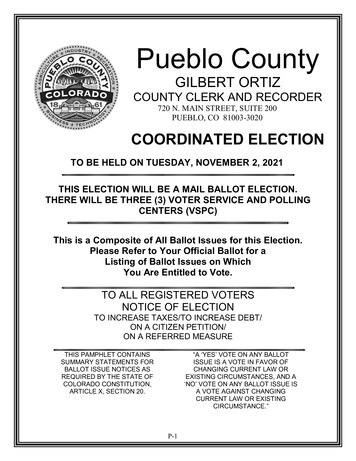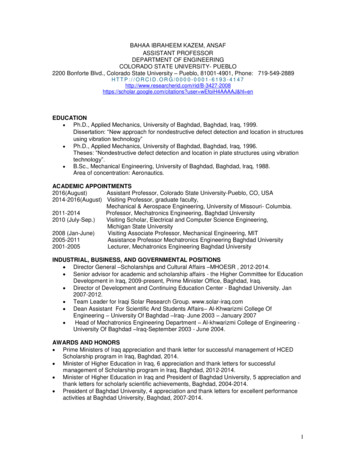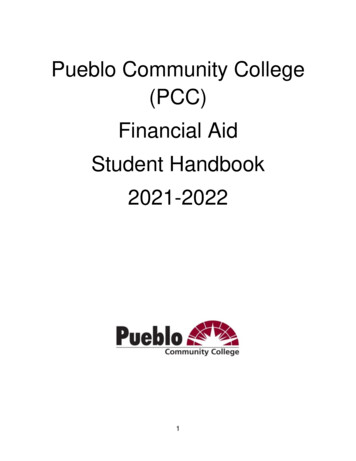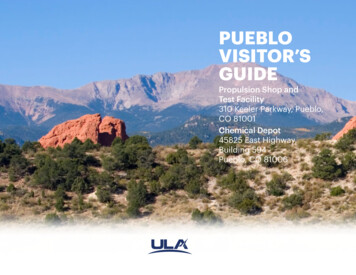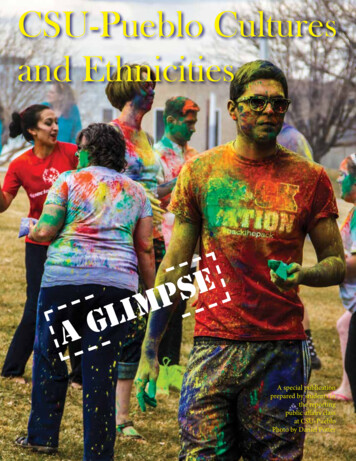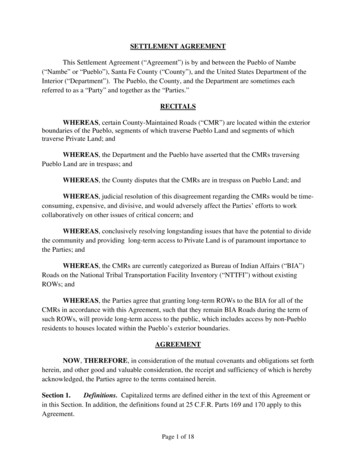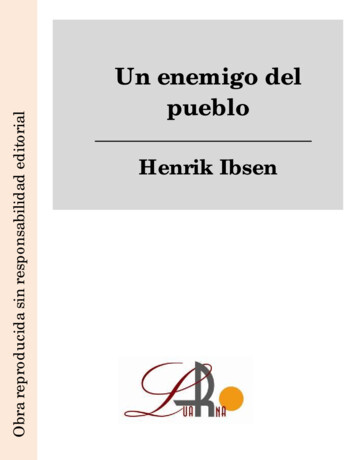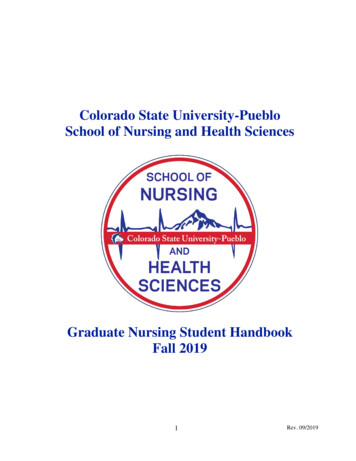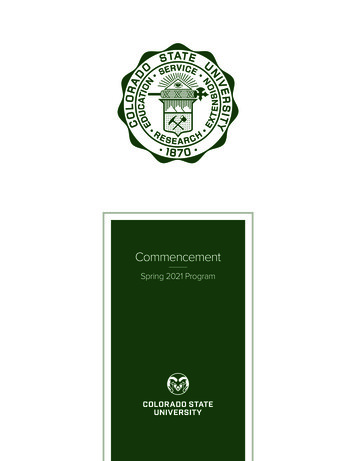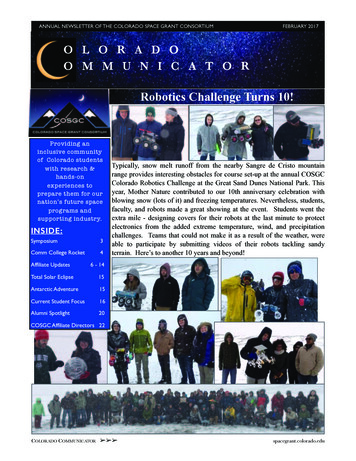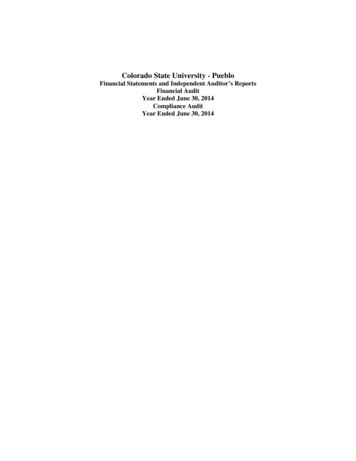
Transcription
Colorado State University - PuebloFinancial Statements and Independent Auditor’s ReportsFinancial AuditYear Ended June 30, 2014Compliance AuditYear Ended June 30, 2014
THIS PAGE LEFT BLANK INTENTIONALLY
LEGISLATIVE AUDIT COMMITTEESenator Lucia Guzman - ChairSenator David BalmerRepresentative Su RydenSenator Kevin GranthamRepresentative Jerry SonnenbergRepresentative Dan NordbergSenator Lois TochtropRepresentative Dianne PrimaveraOFFICE OF THE STATE AUDITOR STAFFDianne E. RayState AuditorKerri HunterDeputy State AuditorCynthia HochmillerLegislative Audit ManagerBKD, LLPContractorAN ELECTRONIC VERSION OF THIS REPORT IS AVAILABLE ATWWW.STATE.CO.US/AUDITORA BOUND REPORT MAY BE OBTAINED BY CALLING THEOFFICE OF THE STATE AUDITOR303.869.2800PLEASE REFER TO REPORT NUMBER 1416F-C WHEN REQUESTING THIS REPORT
THIS PAGE LEFT BLANK INTENTIONALLY
November 26, 2014Members of the Legislative Audit Committee:We have completed the financial statement audit of Colorado State University - Pueblo as of and for theyear ended June 30, 2014. Our audit was conducted in accordance with auditing standards generallyaccepted in the United States of America and the standards applicable to financial audits contained inGovernment Auditing Standards, issued by the Comptroller General of the United States.We were engaged to conduct our audit pursuant to Section 2-3-103, C.R.S., which authorizes the StateAuditor to conduct or cause to be conducted audits of all departments, institutions and agencies of stategovernment. The reports which we have issued as a result of this engagement are set forth in the table ofcontents which follows.
THIS PAGE LEFT BLANK INTENTIONALLY
Colorado State University - PuebloTable of Contents. PageReport Summary . 1Recommendation Locator . 3Financial and Compliance Audit Report Section:Description of Colorado State University - Pueblo . 4Auditor’s Findings and Recommendations . 7Disposition of Prior Audit Recommendations . 18Independent Auditor’s Report on Financial Statements . 20Management’s Discussion and Analysis (Unaudited) . 22Financial Statements:Statement of Net Position . 27Statement of Revenues, Expenses and Changes in Net Position . 29Statement of Cash Flows . 30Statement of Financial Position – Discretely Presented Component Unit. 32Statement of Activities – Discretely Presented Component Unit . 33Notes to Basic Financial Statements . 35Independent Auditor’s Report on Internal Control OverFinancial Reporting and on Compliance and Other Matters Based on anAudit of the Financial Statements Performed in Accordance withGovernment Auditing Standards. 56Independent Auditor’s Audit Committee Communication . 58
Colorado State University - PuebloReport SummaryYear Ended June 30, 2014Purposes and Scope of AuditThe Office of the State Auditor engaged BKD, LLP (BKD) to conduct a financial and compliance audit ofColorado State University – Pueblo (CSU-Pueblo) for the year ended June 30, 2014. BKD performed theaudit in accordance with auditing standards generally accepted in the United States of America, thestandards applicable to financial audits contained in Government Auditing Standards issued by theComptroller General of the United States and U.S. Office of Management and Budget (OMB) CircularA-133, Audits of States, Local Governments and Non-Profit Organizations. The audit of the ColoradoState University – Pueblo Foundation, the discretely presented component unit, was not performed inaccordance with the standards applicable to financial audits contained in Government Auditing Standards.The purposes and scope of the audit were to: Express an opinion on the financial statements of CSU-Pueblo as of and for the year endedJune 30, 2014, including consideration of internal control over financial reporting asrequired by auditing standards generally accepted in the United States of America andGovernment Auditing Standards for the year ended June 30, 2014. Evaluate compliance with certain provisions of laws, regulations, contracts and grantsgoverning the expenditure of federal funds for the year ended June 30, 2014. Issue a report on CSU-Pueblo’s internal control over financial reporting and on compliancewith certain provisions of laws, regulations, contracts and grant agreements and othermatters based on our audit of the financial statements performed in accordance withGovernment Auditing Standards for the year ended June 30, 2014. Evaluate progress in implementing the prior year audit recommendation.CSU-Pueblo’s schedule of expenditures of federal awards and applicable opinions thereon, issued by theOffice of the State Auditor, are included in the Statewide Single Audit Report issued under separatecover.1(Continued)
Colorado State University - PuebloReport SummaryYear Ended June 30, 2014Audit Opinions and ReportsThe independent auditor’s reports included herein expressed unmodified opinions on CSU-Pueblo’sfinancial statements as of and for the year ended June 30, 2014.One material weakness in internal control over financial reporting was identified.One material weakness in internal control over compliance was identified.No instances of noncompliance considered material to the financial statements were disclosed by theaudit.Significant Audit AdjustmentThere were multiple proposed audit adjustments identified during the audit. See page 9 for a summary ofthese adjustments.Summary of Audit RecommendationsFinancial Statement Preparation and Review of Financial RecordsWe identified one finding related to our testing of internal controls over financial reporting. The findingrelates to failure to ensure that a supervisory review of financial records occurs timely such that accuratefiscal year 2014 financial statements could be prepared. (See Recommendation No. 1).Enrollment Reporting (Student Financial Aid Cluster)We also identified a timely reporting issue related to student status changes. We noted 14 out of the 25students’ status changes were communicated to NSLDS 28 to 43 days after the 60-day noticerequirement. (See Recommendation No. 2.)Summary of Progress in Implementing Prior Audit RecommendationsThe audit of the Colorado State University System for the year ended June 20, 2013 noted arecommendation pertaining to CSU-Pueblo. This recommendation was relating to supervisory reviewand reconciliations of all cash and other significant accounts, which were tested by BKD to determineimplementation. We found this recommendation was not implemented and was repeated as part ofRecommendation No. 1.2
Colorado State University - PuebloRecommendation LocatorYear Ended June 30, ionSummaryColorado State University – Puebloshould improve internal controls overfinancial activities by (1) ensuringthrough training and oversight thatreview of account reconciliations andmonitoring of financial information aredone timely and accurately;(2) considering the hiring of anexperienced CPA within its accountingdepartment; and (3) implementing animproved software system to helpimprove the overall controlenvironment.Colorado State University – Puebloshould ensure that it complies withfederal Student Financial Aid programenrollment reporting requirements byimplementing a supervisory review ofthe enrollment reporting process andrequiring that all Student Financial Aidstaff attend training regarding thefederal submission process.3ResponseAgreeImplementationDate1. January 20152. April 20153. June 2015AgreeMay 2015
THIS PAGE LEFT BLANK INTENTIONALLY4
Colorado State University - PuebloDescription of the Colorado State University - Pueblo CampusYear Ended June 30, 2014Organization and AdministrationThe institutions that compose the Colorado State University System (the System) are established inTitle 23, C.R.S. The Board of Governors (the Board) has control and supervision of three distinctinstitutions: Colorado State University (a land-grant university located in Fort Collins), Colorado StateUniversity – Pueblo (a regional, comprehensive university), and Colorado State University – GlobalCampus (an online university).The 15-member Board consists of: Nine voting members appointed by the Governor and confirmed by the Senate for four-yearterms. Six advisory members representing the student bodies and the faculty councils for each of thethree institutions, elected for one-year terms.The Board administers the State Board of Agriculture Fund located in the State Treasury. The Board isauthorized to set tuition, pay expenses, and hire officials. The chief academic and administrative officersare the Chancellor of the Colorado State University System and the President of each institution.Colorado State University - PuebloColorado State University – Pueblo was incorporated in 1935 as Southern Colorado Junior College. Oneyear later, local citizens decided to support the institution with county taxes. They organized the PuebloJunior College District and the school was renamed Pueblo Junior College. In 1951, Pueblo JuniorCollege became the first accredited junior college in Colorado. In 1963, Colorado’s General Assemblyenacted legislation changing Pueblo Junior College to a four-year institution—Southern Colorado StateCollege—to be governed by the board of trustees of state colleges. By then, four new buildings had beenerected on the new campus north of Pueblo’s Belmont residential district. On July 1, 1975, the StateLegislature granted the institution university status. Three years later, the Colorado State Board ofAgriculture assumed governance of the University of Southern Colorado. In July 2003, the universitywas renamed to Colorado State University – Pueblo.Colorado State University – Pueblo (CSU-Pueblo) is accredited at the bachelor’s and master’s levels.CSU-Pueblo is a regional, comprehensive university, with moderately selective admissions standardsdisplaying excellence in teaching and learning. CSU-Pueblo emphasizes professional, career-oriented,and applied programs at the undergraduate and graduate levels while maintaining strong programs in theliberal arts and sciences. CSU-Pueblo has received the federal government’s designation as a HispanicServing Institution granted to universities with at least 25 percent of the student population of Hispanicdescent.Enrollment and FacultyEnrollment, faculty and staff information is presented below and was obtained from institutional analysisand CSU-Pueblo’s Factbooks.4(Continued)
Colorado State University - PuebloDescription of the Colorado State University - Pueblo CampusYear Ended June 30, 2014Colorado State University - PuebloFull-Time Equivalent (FTE) Student EnrollmentNonresidentResidentFiscal 539551Colorado State University - PuebloFull-Time Equivalent (FTE) Faculty and StaffFacultyStaffFiscal otal3,9744,1374,437Total537597599Colorado State University – Pueblo Foundation (the Foundation)The CSU-Pueblo reporting entity includes the CSU-Pueblo Foundation as a discretely presentedcomponent unit. The Foundation is a legally separate, tax-exempt entity that was established to receive,manage, and invest philanthropic gifts on behalf of CSU-Pueblo. The CSU-Pueblo Foundation isgoverned by its Board of Directors, which includes twenty-seven trustees. No person who is an employeeof CSU-Pueblo is eligible to serve as an officer of the Foundation or as a voting board member.5
THIS PAGE LEFT BLANK INTENTIONALLY6
Colorado State University - PuebloAuditor’s Findings and RecommendationsYear Ended June 30, 2014INTERNAL CONTROL OVER FINANCIAL REPORTINGIn planning and performing our audit of the financial statements of Colorado State University – Pueblo(CSU-Pueblo) as of and for the year ended June 30, 2014 in accordance with auditing standards generallyaccepted in the United States of America, we considered CSU-Pueblo’s internal control over financialreporting (internal control) as a basis for designing our auditing procedures for the purpose of expressingan opinion on the financial statements, but not for the purpose of expressing an opinion on theeffectiveness of CSU-Pueblo’s internal control. Accordingly, we do not express an opinion on theeffectiveness of CSU-Pueblo’s internal control.Our consideration of internal control was for the limited purpose described in the preceding paragraphand was not designed to identify all deficiencies in internal control that might be deficiencies, significantdeficiencies or material weaknesses and, therefore, there can be no assurance that all deficiencies,significant deficiencies or material weaknesses have been identified.A deficiency exists when the design or operation of a control does not allow management or employees,in the normal course of performing their assigned functions, to prevent or detect and correctmisstatements of CSU-Pueblo’s financial statements on a timely basis. A deficiency in design existswhen a control necessary to meet a control objective is missing or an existing control is not properlydesigned so that, even if the control operates as designed, a control objective would not be met. Adeficiency in operation exists when a properly designed control does not operate as designed or when theperson performing the control does not possess the necessary authority or competence to perform thecontrol effectively.A material weakness is a deficiency, or a combination of deficiencies, in internal control, such that thereis a reasonable possibility that a material misstatement of CSU-Pueblo’s financial statements will not beprevented or detected and corrected on a timely basis.A significant deficiency is a deficiency, or combination of deficiencies, in internal control that is lesssevere than a material weakness, yet important enough to merit attention by those charged withgovernance.We observed the following matter that we consider to be a material weakness.7(Continued)
Colorado State University - PuebloAuditor’s Findings and RecommendationsYear Ended June 30, 2014Material Weakness-Internal Control Over Financial ReportingFinancial statement preparation and Review of Financial Records: Colorado State University – Pueblo(CSU-P)Colorado State University – Pueblo (CSU-P) is a university within the Colorado State University Systemwith an enrollment of over 4,000 full time equivalents and 57 million in operating revenue. Althoughpart of the CSU System, the accounting for the university operates independently from the otheruniversities within the System; thus, it has its own internal controls and accounting processes.Monitoring of account balances contained in the general ledger, as well as reconciliation of the balancesto supporting financial records, is integral to ensuring the accuracy of financial information. In addition,these processes are necessary in order to minimize the risk of material misstatement due to error or fraud.What was the purpose of the audit work?The purpose of the audit work was to determine whether CSU-P had adequate internal controls andprocesses in place to prepare materially accurate financial statements in a timely manner.What audit work was performed and how were results measured?We tested management’s ability to timely and accurately prepare financial statements. We specificallyperformed testing to determine whether material accounts including receivables, accounts payable,accrued interest, deferred revenue and fixed assets were reconciled timely and accurately. In addition, wereviewed journal entries recorded during Fiscal Year 2014 to determine whether those entries wererecorded appropriately and in a timely manner, and whether they were reviewed by a supervisor.We also performed testwork to determine whether CSU-P implemented our Fiscal Year 2013 auditrecommendation related to inadequate accounting controls. Our Fiscal Year 2013 audit recommendationwas identified as a material weakness. During our Fiscal Year 2013 audit, CSU-P staff made 37 journalentries after fiscal year-end closing, including twenty entries that were individually in excess of 100,000and affected at least one account.CSU-P’s policy requires that quarterly financial statements, which would include fiscal year-end financialstatements, be reviewed by the controller and director of finance. This review should be done in enoughdetail to identify any material misstatements in a timely manner. The results of our testing were alsomeasured by the amount of post-closing entries proposed by management and the amount of journalentries we proposed during the audit. If internal controls are working correctly, the entries required afterthe original close date should be limited to items that require data from third parties and no entries shouldbe identified by the auditors.What problem did the audit work identify?We noted during our testing that CSU-P did not have adequate internal controls in place over its financialactivity during Fiscal Year 2014 to ensure that adequate supporting documentation was maintained andthat account activity and reconciliations were accurate and appropriate. Based on further discussions withCSU-P management and performance of further audit procedures, we specifically noted the following:8(Continued)
Colorado State University - PuebloAuditor’s Findings and RecommendationsYear Ended June 30, 2014 CSU-P recorded seventeen entries after fiscal year closing of the financial statements totaling 20,000,000, including fourteen that individually affected at least one account by over 100,000.These entries adjusted federal grant revenue, accounts receivable, bad debt expense, allowancefor student loans receivable, capital assets, construction in process, depreciation expense,accumulated depreciation, allowance for bad debts, cash, gain/loss on refunding, and tuition totheir reconciled amounts as of June 30, 2014. Of the 20,000,000 in entries recorded after theoriginal closing, 6,800,000 of the adjustments were proposed as a result of the audit, includingthe following five adjustments:ooooo An entry to expense 250,000 in bond issuance costs that were not expensed by CSU-Paccounting staff as required by GASB Statement No. 65, Items Previously Reported asAssets and LiabilitiesAn entry to correct a 5,000,000 transfer from CSU-Global that was incorrectly recordedin a fee-for-service account.An entry to remove accrued interest of 890,000 that was incorrectly recorded twice.Net entries to record 250,000 in accounts receivable that were not previously booked.An entry to record revenue earned for technology fees totaling 683,000 that wasincorrectly recorded as deferred when it had been earned.49 journal entries were deleted in the accounting system, instead of being corrected withreversing journal entries when it was determined that information in the original entry needed tobe corrected.In addition, we found that during the year there appeared to be an overall lack of monitoring forcollectability of receivables. Specifically, management was unable to provide support of internal controlsand processes related to the collection of commercial accounts receivables.Based on the amount of errors and breakdowns in internal control that we identified, the overallsupervisory review was not performed in a manner such that accurate financial statements could beprepared in a timely manner. Further, CSU-P staff did not adhere to existing policies and proceduresrelating to the review and oversight of account reconciliations, including a lack of effective supervisoryreview by both direct supervisors and management in the accounting department and failed to completereconciliations timely.Why did the problem occur?CSU-P staff indicated that, in part, policies and procedures were not followed during Fiscal Year 2014due to turnover in the accounting department and a lack of proper training for new staff on requiredprocedures.The School’s accounting resources were also limited during the fiscal year because there was no CPAemployed in CSU-P’s accounting department. With the lack of a CPA in the accounting department, thedepartment lacks the more technical knowledge over internal controls and accounting issues. A CPAwould also be able to provide assistance with technical issues, such as the adoption of new accountingpronouncements.Additionally, the base accounting system used by CSU-P is a proprietary system called AdministrativeInformation System, or AIS, that lacks controls that are common in most software systems. Thesecontrols would include not allowing journal entries to be deleted after they had been recorded and9(Continued)
Colorado State University - PuebloAuditor’s Findings and RecommendationsYear Ended June 30, 2014maintaining detail of general ledger accounts that agree to the trial balance, which identified accounts atthe summary level.Why does this problem matter?Reconciling and monitoring of financial records is crucial for detecting and preventing misappropriationof funds, misstatements, errors, or fraud on the financial statements. Establishing and maintaining internalcontrols, such as supervisory review, ensures that the reconciliations and reviews will be performed in atimely manner to lower the potential risk of misstatements due to error or fraud on the financialstatements.Timely and accurate financial information is integral to business decision-making. Lack of timely andaccurate reconciliations and monitoring can lead to journal entries that may not be recorded into theaccounting system and failure to identify incorrect entries. This also leads to material year-endadjustments. This can cause inaccurate financial reporting at the CSU-P and statewide levels.(Classification of Finding: Material Weakness)Recommendation No. 1:Colorado State University – Pueblo should improve its internal controls over financial activities by:1) Ensuring through training and oversight that existing policies and procedures related to thereview of account reconciliations and monitoring of financial information is done in a timelyand accurate manner such that the financial statements are prepared accurately and timely.2) Considering the hiring of an experienced CPA within its accounting department to assist withfinancial statement preparation and design of internal controls and processes.3) Implementing an improved software system with strong built in information system generalcontrols to help improve the overall control environment.Colorado State University – Pueblo ResponseAgree Implementation Date: January 20151) The controller will oversee an assessment of policies related to account reconciliations andmonitoring of financial information to implement necessary procedural changes. The universitycontroller has established a monthly checklist that will be used starting in December 2014 byaccountants in Business Financial Services for the remainder of FY 2014-15. Staff in BusinessFinancial Services will be trained by the controller on policies, including the use of this checklist.This training, the checklist and amended procedures, in conjunction with oversight andsupervision of staff by the controller will ensure that all entries and all reconciliations areperformed on a monthly basis. The controller will oversee the process to ensure that checklistsare completed in a timely manner and that proper and sufficient documentation for ledger entriesand reconciliations are made. These steps will enable financial statements to be generated in atimely manner.Agree Implementation Date: April 201510(Continued)
Colorado State University - PuebloAuditor’s Findings and RecommendationsYear Ended June 30, 20142) In September 2014, CSU—Pueblo hired an accountant with over 20 years of higher educationand GASB experience, including 5 years as a university controller. This individual hasexperience with CSU — Pueblo’s legacy information technology system and the new systembeing utilized in FY 2014-15. In the spring of 2014, an accountant played a key role in overseeingthe university’s migration to the KUALI Financial System. In the spring of 2015, the controllerhas determined that this position will oversee the establishment of additional controls andprocedures. Additionally, two new accounting positions have been approved by the President forBusiness Financial Services. An evaluation of applicants for these positions is underway withhiring expected during the first calendar quarter of 2015. The university will consider hiring aCPA, as recommended.3) Agree. Implementation Date: June 2015With assistance from Colorado State University – Fort Collins, CSU-Pueblo implemented a newfinancial system (KUALI) in July 2014. This system will allow for much greater control overentries into the general ledger than our legacy system (AIS). Effective July 1, 2014, all budgetsand general ledger transactions have been entered into this system. KUALI prevents journalentries from being deleted. If adjustments are required, new journal entries are necessary tocorrect errors. Student billing and accounts receivable will still be managed in AIS. During2015, the CSU-Pueblo controller will identify potential improvements in the AIS system toimprove controls over accounting transactions in AIS. The development of internal controls iscontinuous and an ongoing process.11(Continued)
Colorado State University - PuebloAuditor’s Findings and RecommendationsYear Ended June 30, 2014INTERNAL CONTROL OVER COMPLIANCEIn planning and performing our audit of compliance, we considered CSU-P’s internal control overcompliance with the requirements that could have a direct and material effect on a major federal programto determine our auditing procedures and to test internal control over compliance in accordance withOMB Circular A-133.Our consideration of internal control over compliance was for the limited purpose described in thepreceding paragraph and was not designed to identify all deficiencies in internal control over compliancethat might be significant deficiencies or material weaknesses and, therefore, there can be no assurancethat all deficiencies, significant deficiencies or material weaknesses have been identified.A deficiency in internal control over compliance exists when the design or operation of a control overcompliance does not allow management or employees, in the normal course of performing their assignedfunctions, to prevent or detect and correct noncompliance with a type of compliance requirement of afederal program on a timely basis.A material weakness in internal control over compliance is a deficiency, or a combination of deficiencies,in internal control over compliance such that there is a reasonable possibility that material noncompliancewith a type of compliance requirement of a federal program will not be prevented or detected andcorrected on a timely basis.A significant deficiency in internal control over compliance is a deficiency, or combination ofdeficiencies, in internal control over compliance that is less severe than a material weakness, yetimportant enough to merit attention by those charged with governance.We observed the following matter that we consider to be a material weakness.Material Weakness – Internal Control Over ComplianceEnrollment Reporting (Student Financial Aid Cluster): Colorado State University System – PuebloCampusEnrollment Reporting (Student Financial Aid Cluster)Federal regulations mandate that when a student receives Federal student financial aid and subsequentlychanges enrollment status, the school must report the enrollment change to the National Student LoanData System (NSLDS). Specifically, enrollment reporting assists the federal government in managementof the Pell and Direct Loan programs, which are programs within the Student Financial Aid Cluster. Inaddition, the NSLDS assists lenders in the determination of whether a student, whose enrollment statuschanged subsequent to a Direct Loan disbursement and who received Direct Loan program loans, shouldbe moved into loan repayment status or if they are eligible for an in-school deferment. During Fiscal Year2014, Colorado State University – Pueblo (CSU-P) issued approximately 34 million Student FinancialAid during the year, which included approximately 30 million of Pell and Direct Loan funding.What was the purpose of the audit work?We performed procedures required by the federal Office of Management and Budget Circular A-133 andthe related 2014 Compliance Supplement for the Student Financial Aid Cluster. Specifically, we12(Continued)
Colorado State University - PuebloAuditor’s Findings and RecommendationsYear Ended June 30, 2014perfo
Colorado State University - Pueblo Description of the Colorado State University - Pueblo Campus Year Ended June 30, 2014 5 Colorado State University - Pueblo Full-Time Equivalent (FTE) Student Enrollment Resident Nonresident Total Fiscal Year: 2013-2014 3,475 499 3,974 2012-2013 3,598 539 4,137 2011-2012 3,886 551 4,437
